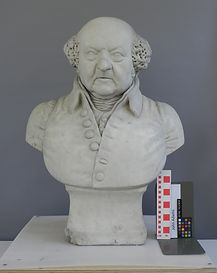Historic Works
Mary Baker Eddy's Carriage Horse Tack at the Longyear Museum, Chestnut Hill, MA


During Treatment

Before Treatment

After Treatment
Mary Baker Eddy was famous for riding her horse-drawn carriage around the streets of Brookline. This set of harnesses, made of tanned and dressed leather with nickel-plated steel rings, buckles, and custom-made monograms, had been stored in an unheated carriage barn and suffered from corrosion and mold damage. Treatment included removal of mold, de-greasing, and cleaning of all metal parts. A leather cream toned with dry pigment visually improved areas of severe damage.
Marble bust of John Adams by M. J. Binion at Faneuil Hall, Boston

Preparing for Treatment
Before Treatment

After Treatment

During Treatment
The marble bust of John Adams was extremely dirty and visually disfigured from a previous restoration of the nose. The bust was cleaned with a mild detergent followed by steam cleaning, and the nose restored using reversible conservation materials. The sculpture sits on a pedestal on the stage of Faneuil Hall between bronze busts of Frederick Douglass and Lucy Stone.
Sculpture of American Eagle at Faneuil Hall, Boston

Before Treatment

After Treatment

During Treatment
The towering sculpted eagle overlooking the interior of Faneuil Hall was designed in 1798 by Daniel Raynerd and is an early example of artificial stone. It was originally placed outdoors at the First United States Branch Bank of Boston, but moved to Faneuil Hall in 1824 when the bank building was demolished. Analysis indicated that the original color may have been white but subsequently painted in the more realistic darker colors and gold leaf. The sculpture was extremely dusty and dirty and there was flaking paint in all areas. There was also flaking paint on the tin plate banner, a later addition to the sculpture. The sculpture was cleaned, flaking paint stabilized, and the metal banner returned to its previous location following a historic 1852 photograph provided by the National Park Service.
Shovel Preservation Project, Stonehill College, Easton, MA




This project involved 774 shovels, forged, silvered, and with historic paper labels! The Shovel Preservation Project at the Stonehill Industrial History Center was a preventive conservation project funded by the Institute of Museum and Library Services and by Nancy Ames, a descendent of Governor Oliver Ames. Although the extensive shovel collection had previously been inventoried, they had not been photographed, assessed, or treated. The focus of the project was to examine and photograph each object, remove corrosive recent adhesive tape and labels, stabilize rust, re-adhere and wrap all paper labels, and upgrade the storage facility. The project included chemistry, industrial history, paper conservation, and contemporary museum registration techniques. Favorite shovels of the team include the potato scoop, ice harvesting tools, the fox hole digger, a coal cleanout shovel, and silver-plated shovels created for the 1876 Centennial Exhibition in Philadelphia.
Polychromed Wood Eagle Sternboard at the New Bedford Whaling Museum


The sternboard was made in 1851, and placed on the front of the whaling ship The Atlantic, sailing from New Bedford, Massachusetts. After 8 whaling voyages, the ship was transferred to San Francisco and then shipwrecked. The sternboard, however, had been removed from the ship to decorate a shipwright's home in New Bedford. The eagle was examined for fabrication information, and the conservators noted vestiges of gilding and numerous colors of paint. The paint was flaking and three wood fragments had become detached. Lifting paint was stabilized with sturgeon's glue, wood fragments returned to place, and the surface lightly cleaned.
